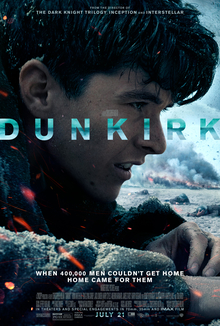Explore our in-depth review of Dunkirk (2017), Christopher Nolan’s gripping World War II epic. A cinematic spectacle driven by realism, tension, and survival. BMR Rating: 9/10.

Dunkirk movie review | survival in wartime
Introduction
When it comes to large-scale, immersive filmmaking, Christopher Nolan is a name that resonates with innovation and impact. With Dunkirk (2017), Nolan tackles one of the most pivotal events of World War II — the evacuation of Allied soldiers from Dunkirk, France — and delivers a taut, visceral experience unlike any conventional war film. By avoiding sentimentality and focusing on pure survival, Nolan crafts a cinematic experience that is both relentless and emotionally resonant.
Plot Summary: A War Story Told in Three Dimensions
Set in 1940, during the early days of World War II, Dunkirk dramatizes the evacuation of over 330,000 Allied soldiers trapped by German forces on the beaches of Dunkirk. What makes this film stand out is its non-linear narrative, told from three intertwined perspectives:
- Land (“The Mole”) – spanning one week, focusing on a young British soldier, Tommy (Fionn Whitehead), as he struggles to survive and escape.
- Sea (“The Sea”) – covering one day, featuring civilian boat owner Mr. Dawson (Mark Rylance), who sets sail across the English Channel with his son and a friend to help rescue soldiers.
- Air (“The Air”) – set over one hour, following RAF pilot Farrier (Tom Hardy) as he provides cover to the men below.
The timelines eventually converge in a climax that’s as emotional as it is thrilling.
Performances and Characters
Unlike many war films that center on a few heroic figures, Dunkirk focuses on the collective human experience. The characters, often with minimal dialogue, are conduits for emotion and perspective:
- Fionn Whitehead delivers a naturalistic performance as Tommy, embodying fear, desperation, and resolve without relying heavily on dialogue.
- Mark Rylance as Mr. Dawson represents quiet heroism and civilian courage.
- Tom Hardy, even with his face mostly hidden behind a pilot mask, conveys calm professionalism and silent sacrifice.
- Harry Styles, in his acting debut, surprises with a solid, understated performance as a fellow soldier.
Supporting cast members like Kenneth Branagh, Cillian Murphy, and Barry Keoghan contribute depth and humanity to a story that intentionally avoids focusing on any one individual.
Direction and Storytelling Style
Christopher Nolan breaks away from traditional war film storytelling. There are no lengthy monologues, no political speeches, and no backstories. Instead, the audience is thrust into the middle of the action, immersed in the characters’ confusion and fear. Nolan’s non-linear structure heightens tension, making the audience piece together the full scope of the evacuation from disjointed yet interconnected fragments.
Nolan’s decision to minimize CGI and rely on practical effects, real ships, and vintage aircraft enhances the realism. His minimalist script lets the environment and action do the talking, creating an almost silent-film approach to suspense and drama.
Cinematography and Editing
Hoyte van Hoytema’s cinematography is stunning, with vast, cold, and hauntingly beautiful shots of beaches, open sea, and dogfights in the sky. The use of IMAX cameras and real 70mm film lends grandeur and authenticity to every frame. The aerial combat scenes are especially breathtaking, placing the viewer inside the cockpit with claustrophobic intensity.
Lee Smith’s editing is masterful, seamlessly weaving together three different timelines and tones without confusing the audience. The structure builds to a crescendo where all narratives intersect in a satisfying payoff.
Music and Sound Design
Hans Zimmer’s score plays a crucial role in elevating Dunkirk to a nerve-wracking experience. Using techniques like the Shepard Tone, Zimmer crafts a soundtrack that gives the illusion of ever-rising tension. Combined with the ticking of a watch and the roar of engines, the soundscape acts as an invisible character driving the urgency.
The sound design — from bullets whizzing past to the roar of a dive bomber — is deafeningly realistic. It is intentionally overwhelming, placing viewers right in the heart of war.
Themes and Impact
At its core, Dunkirk is about survival, sacrifice, and collective resilience. It’s less about victory and more about endurance. Unlike jingoistic war films, Nolan emphasizes the fear and futility of war, while also highlighting small moments of bravery — both from soldiers and civilians.
The movie stands out because it eschews Hollywood-style heroism. There are no over-the-top speeches or melodramatic scenes. Instead, the quiet dignity of survival is celebrated.
Box Office and Reception
Made on a budget of $100 million, Dunkirk earned a massive $530.4 million worldwide. It was universally acclaimed and received eight Academy Award nominations, winning three (Best Editing, Best Sound Editing, and Best Sound Mixing).
Critics praised it as one of the greatest war films ever made, and it is often considered one of Christopher Nolan’s finest achievements.
Conclusion
Dunkirk (2017) isn’t just a war movie — it’s an experiential journey. With minimal dialogue, non-linear storytelling, immersive sound design, and practical visual effects, Christopher Nolan turns a historical event into a visceral survival thriller. It’s a film that demands to be seen on the biggest screen possible and felt in your bones.
BMR (Best Movie Review) Rating: 9/10
Pros:
- Innovative storytelling
- Realistic sound and visuals
- Strong ensemble cast
- Powerful emotional impact
Cons:
Non-linear structure can be disorienting at first
Minimal character development may not appeal to everyone